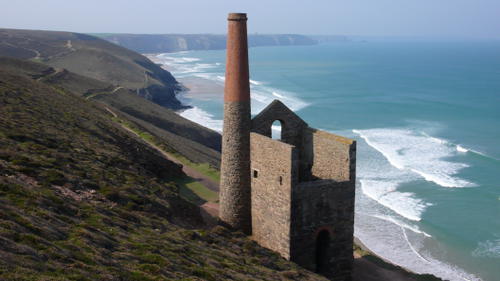Guide 6 – Case Study: Cornwall and West Devon Mining Landscape (United Kingdom)
Baseline Situation
The Cornwall and West Devon mining landscape was inscribed on the World Heritage List in 2006 comprised of 10 different mining landscapes across the area. As the largest World Heritage site in the United Kingdom, covering almost 20,000 hectares, the diverse site needed an effective tourism infrastructure to address challenges of multiple ownerships, limited core resources, and unlocking the full potential of the World Heritage site. Furthermore, these issues had to be addressed and implemented during one the most severe global financial crises in history.

What did they do?
A substantial coordinated investment was needed to begin building the proper visitor infrastructure for this new World Heritage site. In 2007, the Rural Development Programme for England (RDPE) opened a funding programme and the World Heritage site submitted an Expression of Interest. Their submission identified the need for proper infrastructure using an integrated approach not simply for tourism, but also product improvement, business, engagement, and promotion. With the invitation for a formal bid, the site was able to secure £2.4m, which resulted in the ‘Discover the Extraordinary’ (DtE) project. This initiative began in January 2010, and over £1m was invested into improving visitor facilities at 11 partner mining attractions, as well as refining interpretation of the wider landscape as a whole, with the aim to help tourists understand the story of Cornish mining and its significance as World Heritage.
Strategic Priorities
- Improve the World Heritage site destination “product” and the visitor’s experience through improved visitor facilities and enhanced information, interpretation, and orientation.
- Implement the World Heritage site Key and Area Centres to provide strategic World Heritage site interpretation and orientation for visitors.
- Build relationships across the wider tourism industry and enable rural tourism businesses to benefit from World Heritage site status.
- Communicate the enhanced tourism offer to target markets.
- Convert awareness into increased World Heritage site landscape motivated visitors to Cornwall and West Devon.
- Encourage visitors to choose environmentally sustainable options.
What worked?
The investment in infrastructure allowed for the DtE program to put money towards developing a highly functioning integrated marketing strategy that focused on building connections across the tourism sector and widely promoting the site as a cultural tourism destination. This had a significant impact on the11 visitor attractions within the site, and also resulted in business growth across the tourism sector throughout the supply chain. Their activities have produced concrete numbers that have shown increased exposure, visitor spend, job creation, and an upward trend for continued growth. For example, throughout the implementation of the project the visitor spend grew 20% among heritage related business in the area, with an average increase of 138% in visitor spend/income for those same businesses. Visitors also cited World Heritage site specific information as their reason for visiting Cornwall, which saw an increase from 14% to 32%, with 8 out of 9 attractions expecting to see an increase in visitor numbers.

What was tough?
The Cornwall and West Devon WHS was forced to initiate plans and operate amidst one of the most extreme financial crises in history. It found itself navigating through the turmoil and confusion of a swiftly changing and extremely unpredictable economic environment in regards to: visitor behaviour, visitor interests, and visitor spend. Furthermore, the programme also had to deal with unstable data. Local authority resources were not what they had previously been, and local businesses were forced to re-prioritise to meet the challenges brought on by the economic recession.
How did they get buy-in?
Those working in the DtE program knew that success of this project relied largely on continued strategic communication with all relevant stakeholders, encouraging involvement and engagement, especially with the special economic situation in which they would have to work. This open dialogue allowed for local businesses and governing authorities to get involved at step one and become owners of the initiative, building the necessary relationships across the value chain.
What are the results?
The 3.5 year project has resulted in benefiting the community of Cornwall and West Devon across all sectors--the physical infrastructure of the facilities, wider stakeholder engagement, and participation in multiple fields (heritage, arts, tourism, landscape, and community partnerships). Over 400 local businesses are currently active and directly working together within the programme. This has resulted in the creation and access to high quality digital tools for both the visitor and local businesses, as well as providing a platform to communicate a deeper understanding and quality experience of the WHS.
In fact, this past November, the World Heritage Partners were recognized for the second year in a row for its achievements at the Cornwall Tourism Awards under several themes, including a double gold champion as a self-catering, sustainable tourism destination.
What lessons can others take from this?
When developing an infrastructure for a World Heritage site, consider what relationships will be necessary to make this process a smooth transition. It is not only securing investment for improvement that is important in optimizing the visitor experience. Cornwall and West Devon recognized this fundamental aspect. Funds would pay for changes, but the pace would be much slower without buy-in and support from local businesses and authorities.
With community and business cooperation across all sectors, Cornwall and West Devon was able to implement and execute a clear and achievable integrated marketing strategy throughout an economic recession—not only surviving, but thriving. This theme of ‘community buy-in’ is discussed thoroughly throughout this Toolkit for a reason. It leads to success. Remember it as a necessity for your own site and destination when you formulate your Tourism Strategy and Implementation Plan.
Find more information about the "Discover the Extraordinary" (DtE) in their Project Evaluation Summary.


